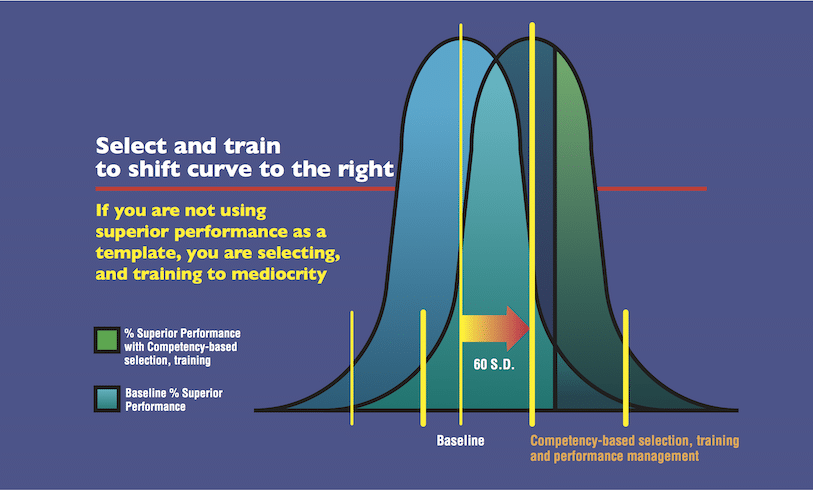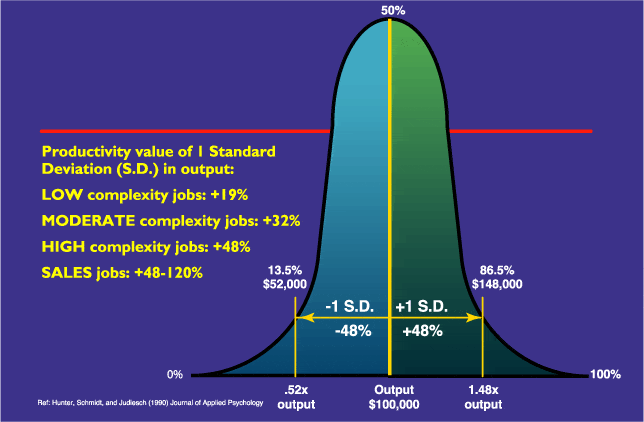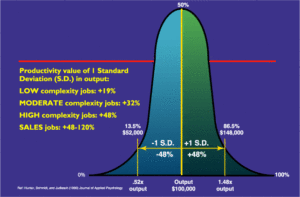Seven Factors To Consider Before Implementing Competency-Based Talent Management
Job competency models describe what superior performers actually do on a job that produces superior results. Armed with this information, selection, retention, training, succession planning and performance management systems can be integrated and designed that will attract, develop and retain top performers.
Superior performance that produces superior results means higher sales, productivity and profits. And everything can be measured. Which explains why many organizations have embraced competency technology. It has provided HR departments with a golden opportunity to demonstrate to line management that HR is able to “add value” that drops to the bottom-line.
However, there are seven factors to consider before embarking on the competency journey – factors that can make or break your best efforts.
1. Accept or modify the terminology – then educate the users (usually all employees).
The language that consultants use to describe competency technology is often confusing, misleading and filled with jargon- not unlike everything else we do. It starts with the definition of competencies.
Most consultants define a competency as “ a skill, knowledge, motive, attitude or characteristic that causes or predicts outstanding performance” (or some similar variation). Most dictionaries, however, define competence and competency as “sufficient” or average performance as in “competent to stand trial”. Several HR directors have told me that, with the flip side of “competent” being “incompetent”, they are concerned that the image that competency systems raises for some people is that of incompetence, an implication that people are incompetent until, of course, receiving the benefit of competency technology.
How unfortunate. Because one of the purposes of competency technology is to help competent people become more competent – in areas where increased competence will produce superior performance. Each of us has strengths and areas where we can improve. Competency technology just does a better job of identifying the specific competencies that drive superior performance and assessing the degree to which individuals have demonstrated those competencies. Our experience has been that once employees understand the concept and purpose of competency modeling , they accept it. If it were to continue to be a problem, then change the name.
A competency model does a better job of conveying the idea of superior performance because the word model means “something to be copied or imitated”. A job competency model, therefore, is a “blueprint” for all current and prospective job holders to copy, that includes a list of competencies that are required for superior performance. Competencies required for average performance, those required to just survive in a job, can also be spelled out in a job model.
The point here is: don’t expect everyone to immediately understand and appreciate the significance of competency modeling. Some may feel threatened by it. So, go slow and educate people up-front and as you progress.
2. Think in terms of measurable payoffs.
The key question to ask yourself and others in your organization is: “what is superior performance worth?” This is easier to answer for some jobs than others, but there is an answer for every job. It first requires clarity about performance measures.
Since sales jobs have fairly clear measures, let’s look at sales jobs to illustrate the point. In one organization, the average annual sales for all sales people were $3.0 million. The top sales people averaged $6.7 million in annual sales. Superior performance was worth $3.7 million in sales per sales person. Now translate this into the bell-shaped curve that depicts the distribution of performance ratings in many organizations. If you can, in fact, increase the percentage of superior performers and move the curve to the right, you will add economic value. Each sales position that is filled by a superior performer, in the case above, will add $3.7 million of sales per year. Read more in “The ROI of Competency Technology“, also available as a Powerpoint presentation.
Line executives understand this kind of thinking, where they often do not understand other HR approaches that are seen as having little impact on the bottom line.
3. Consider alternative approaches, including “doing-it-yourself”.
There are many ways to do competency models. Some are complex, time-consuming and expensive. Others are not. The tradeoffs have to do with validation and thoroughness, although the less complex approaches can include a validation step.
If you are doing more than one model, you should consider using an integrated approach that utilizes a common set of building block competencies, customizable for each job. Each model requires four to eight days of an internal or external consultant’s time, including facilitation of a focus group of high performers, interviews and model development.
Pick an external consultant to get you started who is willing to transfer their methodology to you and train your staff to carry on the work, and/or have them attend Workitect’s three-day Building Competency Models workshop. Workitect Competency Dictionary licensees also have access to a Quick-Start Competency-Modeling instructional program.
For a large retail organization, we did the first two models while certifying an internal HR manager to do additional models. She also designed and implemented selection and performance review applications based on the models. Structured interview questions were developed for each key position to help hiring managers assess and select candidates with the required competencies. Performance goals and results forms were also developed.
4. Start small, don’t oversell, but start with a critical job.
The best way to demonstrate the payoffs of a competency approach is to start with a high impact job or one that is requiring attention, i.e. high turnover, impact on company’s sales, etc. Define the measurable outcomes of doing the model and specify applications.
For example, if you want to do a model of a software developer position, include an application of a selection system and interview guide that will allow you to expand the candidate pool and select superior performing software developers. Other applications can be added, but you should start with at least one visible and measurable outcome for the model. If outcomes and applications are not built in, competency modeling may be perceived as a HR exercise without payoffs.
There is a natural tendency to want to start with a low risk, low visibility position, in order to evaluate the process and the consultant. You are better off doing your homework and thoroughly checking references before selecting a consultant than to waste an opportunity to make an impact that can multiply through out the organization.
The ideal place to start is with the top executive group. Getting that group to develop a model for their position assures total buy-in. They have probably already gone through some strategic planning exercises that included thinking about their organization’s “core competencies”. Developing a model helps them understand the job competency process and align it to the company’s strategy. For example, if innovation is a desired core competency, then a “fostering innovation” competency may be included in most models in order to drive the kind of change needed. An executive model is also needed for a good succession planning system.
5. “One size fits all” model or multiple models for multiple jobs.
Some organizations use a generic model for all management positions. The model may have been one developed externally to cover all management jobs in all industries. Or it may have been developed internally by surveying senior executives asking them what they thought were the key characteristics required for success in their organization. Both approaches are inexpensive to adopt.
The prime disadvantage is lack of validity in a specific organization. The externally developed model may miss several key competencies that may really make the difference between superior and average performance in your unique culture. The internally developed list is often based on opinion and false assumptions and not on hard data. There can also be a communications gap. One CEO insisted that his organization hire and develop people “with a fire in their belly”. He didn’t mean finding people with ulcers, but it did take a competency model to va lidate his opinion and to clearly and concisely describe the qualities of people who were actually successful in that organization.
lidate his opinion and to clearly and concisely describe the qualities of people who were actually successful in that organization.
The opposite end of the spectrum is to do models for every job in an organization, which is costly and unnecessary. Job models are not necessary for every single job in an organization. Jobs can be grouped into like categories or levels. For example, ten different positions in an information systems department may grouped into three levels.
For another manufacturing company, this is the process that was followed. Thirteen key management and professional positions at the plant and headquarters facilities were completed within a relatively short period of time.
6. Maximize the uses and benefits.
There are many possible applications and uses of competency models. Unfortunately, alot of organizations go to the trouble of developing models, use them for one purpose and put them on the shelf. Here are some ways in which you can take full advantage of competency models. Use them to:
- Integrate all HR processes using a common framework to select, train and reward people.
- Assess internal and external candidates using assessment exercises, interviewing and instruments.
- Develop a model for high performing teams. Select and train team members, applying the “fostering teamwork” competency.
- Expand hiring and succession pool. Models may challenge assumptions about required competencies and identify alternative sources of talent
- Retain key employees. Target retention of top performers. Employees who see expanded opportunities for growth are more likely to stay (also impacts morale).
- Redesign jobs. Analysis of a job during model building can reveal ineffective job design plus suggested improvements from focus group.
- Certify competence levels. Design certification programs to develop and reward competency development.
- Design 360° feedback instruments and other developmental tools.
- Determine staffing of merged organization. Keep the top performers in the key positions.
- Create the learning organization. Use the models as templates to guide development.
7. High tech or low tech?
Competency technology has evolved to the point where you can now buy software programs to help construct competency models. These programs contain competency dictionaries, i.e. lists of competencies that can be used to analyze jobs. Some companies have designed their own customized programs for the same use. As we move closer to computerizing all paper transactions and making greater use of the intranet, this seems to make sense. The more we can use technology to simplify our lives, the better.
However, the process of developing competency models remains basically a human process. It requires interviewing, collecting and analyzing data, observing behavior, skillful facilitation of a focus group and drafting a model document. Judgment, ability to react and adapt to situations, to deal with conflict and resistance and uncover unexpected opportunities to improve an organization’s performance are required.
Using automated tools to assist in the application of competency technology is a good idea. Employees who can access competency models and developmental opportunities through a computer terminal feel more empowered and more in control of their destiny. Just be careful to not put the cart before the horse. Remember GIGO (garbage in, garbage out)? Develop good models and good systems before computerizing. Concentrate first on practicality and fit, not on technical sophistication.
Conclusion
The downside of outlining all the things one should consider before doing something is that it will have the unintended effect of discouraging the reader from doing the “something”. Hopefully, that will not be the case here because the payoffs for your organization and for you personally of undertaking a competency approach far outweigh the pain you may incur. Thoughtful consideration of the seven tips described above should minimize the pain and maximize the gain.
Want some help?
Workitect provides consulting services and tools to help organizations to successfully develop and implement competency frameworks, models, and talent management applications.
Find free articles, publications, and user guides here.
Workitect, Inc.
www.workitect.com
Telephone: 954-938-5370 or 866 939 2792, Email: info@workitect.com







Leave A Comment